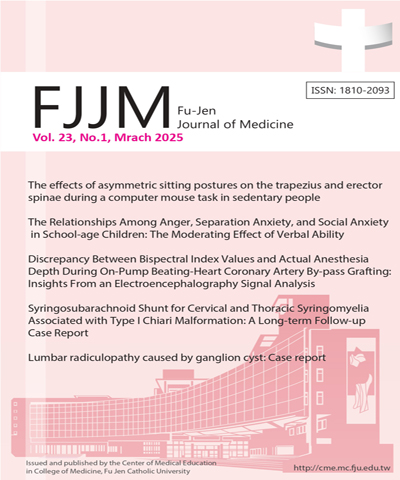
輔仁醫學期刊/Fu-Jen Journal of Medicine
輔仁大學醫學院,正常發行
選擇卷期
- 期刊
Background and purpose: Hemorrhoids is a common disease, but its prevalence, patient population and health seeking behavior were not reported in Taiwan. The purpose of the study is to evaluate the prevalence of hemorrhoids and to explore the factors of undergoing surgical treatment such as gender, age, and Charlson comorbidity index. Methods: We used a nationally representative dataset (Taiwan's National Health Insurance Research Database) containing 1,000,000patients, who were randomly sampled from the years 2000,2005, and 2010, respectively. Information of diagnosis, examination, and treatment were further retrieved. The factors in relation to undergoing surgery for hemorrhoids patients were analyzed by logistic regression model. Results: 1. From 2000 to 2010,the crude prevalence of patients with symptomatic hemorrhoids increased from 1.37 to 2.01%, and the adjusted prevalence increased from 0.58 to 1.01%. 2. From 2000 to 2010,the proportion of patients undergoing surgical treatment decreased from 39.6 to 27.4%.Among all types of medical facilities where the surgery was carried out, clinics had the highest proportion (37.23%,p<0.05).Patients without comorbidities also had higher proportion as compared with those with comorbidities. (29.57%, p < 0.05). 3. From 2000 to 2010, the proportion of patients undergoing total hemorrhoidectomy decreased from 13.06 to 7.75%. The proportion was highest in regional hospitals and in patients without comorbidities. Conclusions: From 2000 to 2010, the prevalence of hemorrhoids increased in Taiwan, whereas the proportion of patients undergoing surgical treatments decreased. Patients with a higher comorbidity score had a lower surgical treatment rate. The highest proportion of medical facilities undergoing surgical treatment for hemorrhoids was clinics.
- 期刊
Background and Purpose: Prolonged mechanical ventilation (PMV) is associated with a disproportionate use of intensive care units and hospital resources and high in-hospital and postdischarge mortality. Ventilator-associated pneumonia (VAP) is one of the most common infections in patients requiring PMV. Objectives: This study analyzed real-world data from Taiwan's National Health Insurance Research Database to evaluate the impact of VAP on medical care among patients with PMV. Methods: This study was a nested case-control study. Cases were PMV patients with newly diagnosed pneumonia (n=2,248) and controls were PMV patients without complicated pneumonia (n=2,248). Odds ratios (ORs) and 95% confidence intervals (CIs) derived from conditional logistic regression models were used to evaluate the impact of PMV with or without pneumonia on medical care. Results: Cases with VAP was associated with a significantly higher risk of admission to rotary ICU (adjusted OR, 1.27; 95% CI, 1.12-1.45), return down home care (adjusted OR, 2.00; 95% CI, 1.38-2.90), and return down respiratory care ward (adjusted OR, 2.01; 95% CI, 1.76-2.30), as compared with controls with non-pneumonia PMV. Conclusion: This study demonstrates that VAP might be a crucial factor for medical care among patients with PMV. Our results are highly clinically relevant for the management of patients with PMV. Future prospective studies is warranted to validate our findings.
- 期刊
Delayed contralateral epidural hematoma is a rare but well-documented complication in patients following decompressive surgery for acute subdural hematoma. However, instances of delayed contralateral epidural hematoma with an overlying skull fracture before acute subdural hematoma evacuation have rarely been documented. In this report, we present the case of a 15-year-old girl with a left-sided acute subdural hematoma and right-sided skull fracture after sustaining a head trauma. Forty- nine minutes after the initial computed tomography scan, dilation of the right pupil occurred and a large delayed right-sided epidural hematoma was confirmed through a subsequent computed tomography scan. We review and discuss the possible mechanism.
- 期刊
Background: The innovated iNAP system creates a negative pressure in oral cavity by applying a suction power through the soft mouth bite. Theoretically, the tongue and soft palate are pushed forward by the pressure differences between upper airway and oral cavity and keep airway potent. Objective: This study applied dynamical magnetic resonance imaging (MRI) to explore the effect of the negative pressure on the upper airway structure and the relationship between the structural changes of the upper airway and the effectiveness of treatment for OSA patients. Materials and Methods: After consent form was signed, the subject underwent dynamical and 3 dimensional MRI scan with and without iNAP. Then, the subject was asked to sleep and the same MRI procedure repeated while the iNAP was turned off or on. The volume and area of different segments of the upper airway were calculated from the MRI images by a commercial program. The differences in the upper airway volume and area between iNAP on and off or between the subject with and without mouth bite were analyzed. In addition, the subjects were subdivided into responder and non-responder by whether the AHI can decrease 50% and lower than 20 after treatment. The characteristics of the upper airway in responder and non-responder were compared. Results: Totally 10 subjects were recruited and aged 36.9±6.04 years. There were 7 subjects respond to the treatment and the AHI was significantly decreased after treatment (14.1±10.82; P=0.0009). The volume of the upper airway was significantly increased when iNAP was turned on during both awake (P=0.005) and sleep (P=0.001). The maximal and minimal areas of upper airway were also significantly increased when iNAP was on during both awake (P=0.0002 and P=0.0042 respectively) and sleep (P=0.0068 and p=0.0161 respectively). The baseline characteristics of the upper airway during awake showed no differences between responder and non-responder. Conclusion: The severity of AHI can be significantly ameliorated in most of the patients by iNAP. The effect of the treatment can be mainly attributed to the increased the upper airway area and volume during both awake and sleep. A larger group of the non-responder warranted for further study to understand the limitation of the treatment and improve patient selection.

